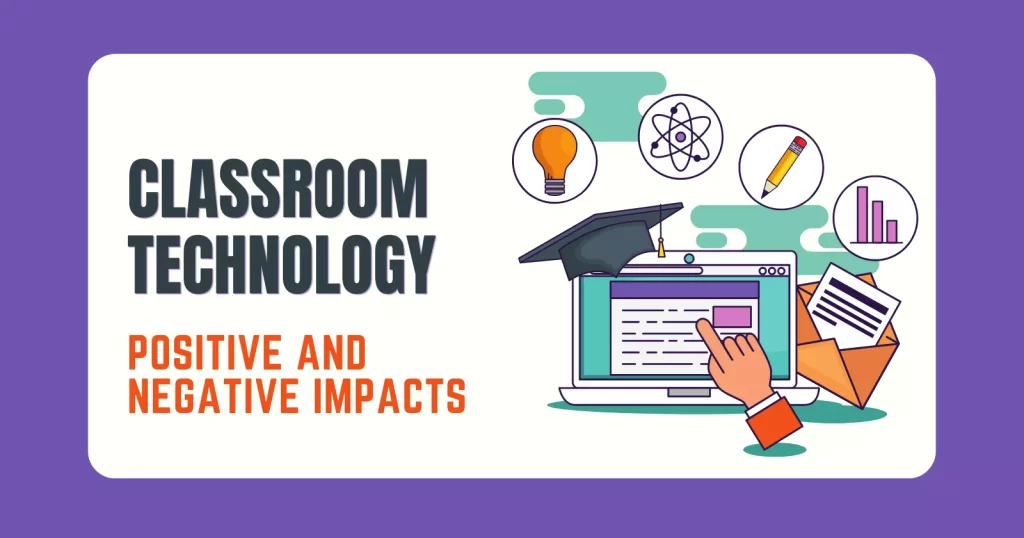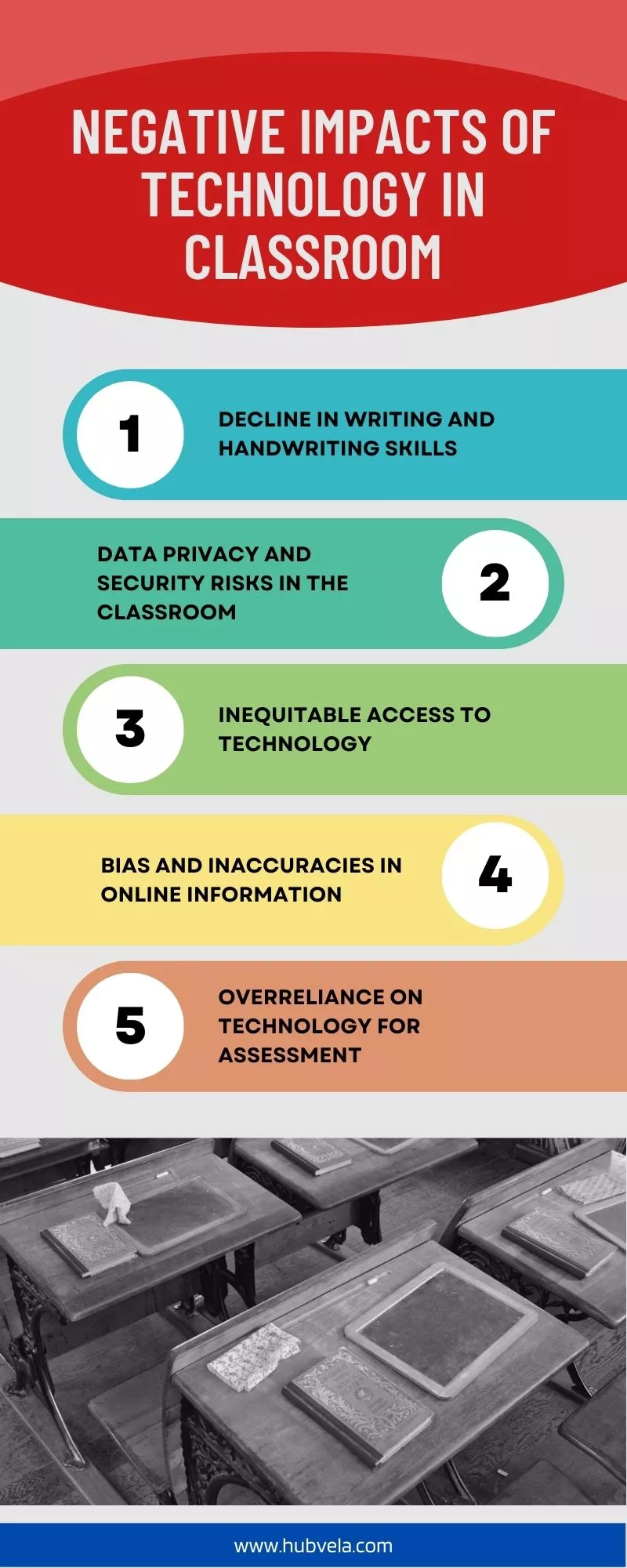Technology has become an integral part of modern education, with many schools and universities adopting various forms of technology to enhance the learning experience.
While technology can have a positive impact on students, it can also have negative effects. The positive effects of technology in the classroom include increased student motivation, enhanced student engagement, and improved learning outcomes.
However, there are also downsides to using technology in the classroom such as potential distractions and over-reliance on technology.
In this article, we will explore the positive and negative impacts of technology in classroom.

--Advertisement--
Positive Impacts of Technology in Classroom
The positive impact of technology on the classroom is undeniable. The use of technology in the classroom can help teachers connect with their students in new ways, open up lines of communication, and explain curriculum material in a more engaging way.
Studies have shown that integrating technology into the classroom can improve student learning and prepare them for future digital demands.
Technology also enhances the learning process by providing students with access to a wealth of information and resources.
Additionally, it brings students together through discussion and collaboration tools, who might never have considered working together before.
Some of the major positive impacts of technology in classroom will be discussed in detail.

1. Increased Access to Information and Resources
Technology has transformed the way students access content, resources, and materials. It enables continuous access to information and knowledge.
Teachers can present subjects in more interactive and creative ways using technology. Students can easily find leveled programs and information sources at the simple click of a button.
Technology causes students to be more engaged, which often leads to better retention of information. Overall, technology provides students with increased access to information and resources that can enhance their learning experience.
2. Enhanced Personalized and Active Learning
Technology can be used to create personalized learning experiences for students, allowing them to learn at their own pace and in their own way.
This can increase student motivation and engagement, leading to better learning outcomes.
Additionally, technology can be used to provide active learning opportunities, such as interactive simulations or collaborative projects.
These types of activities can help students develop critical thinking and problem-solving skills while also promoting social interactions.
Overall, the use of technology in the classroom has many benefits that can enhance teaching and student learning outcomes
3. Increased Engagement and Motivation
Technology creates a more engaging learning environment for students, which leads to better retention of information.
In schools with a positive culture towards technology integration, more students and teachers tend to utilize technology, leading to increased motivation.
Students and teachers have positive attitudes towards technology integration and feel that it has positive impacts on learner satisfaction, promotes student engagement, and leads to success.
Appropriate classroom technology boosts students’ academic achievement, self-confidence, motivation in class, and attendance.
4. Improved Accessibility and Inclusion
Technology can help break barriers for students with disabilities and provide them with access to the most effective learning tools.
It also allows some students to be included in the classroom in ways they have never been before.
Digital technologies have largely untapped potential for improving education and fostering students’ well-being and inclusion at school.
The effective use of digital learning tools in classrooms can increase student engagement, help teachers improve their lesson plans, and create positive outcomes.
Therefore, technology can play a significant role in promoting accessibility and inclusion in classrooms
5. Better Assessment and Feedback
Technology allows for more effective feedback from teachers to students, which can lead to improved learning outcomes.
Additionally, technology can increase interactivity and class engagement, leading to better comprehension overall.
Collaborative work facilitated by technology can also have a positive impact on higher-level thinking skills.
While the evidence on the impact of prerecorded lessons is not yet conclusive, short instructional videos have shown promise in improving student learning outcomes
6. Improved Preparation for the Workforce
Technology can provide students with skills that are essential in today’s job market, such as digital literacy and collaboration.
It can also help students learn subjects outside of the classroom, which can enhance their understanding of the material.
Additionally, technology can increase student engagement with the material, which may lead to better learning outcomes.
Overall, technology has many benefits in the classroom that can help prepare students for success in their future careers.
Negative Impacts of Technology in Classroom
While technology can have many positive effects on students, such as equipping them with technical skills and enhancing learning, it can also have negative impacts.
This includes adverse health effects from excessive screen time, distractions from homework and classwork, and a decline in writing skills due to the use of digital tools.
In this context, it is important to examine the negative impacts of technology in classroom to ensure that its use is balanced and effective for students’ overall well-being.

1. Decline in Writing and Handwriting Skills
According to a 2013 survey, teachers reported that digital tools have had a negative impact on students’ writing and verbal skills.
While technology has impacted academic writing skills both positively and negatively, there is evidence that the lack of instructional continuity in language arts classrooms could lead to a decline in writing proficiency.
Additionally, research suggests that students are poorly prepared to write due to inadequate instruction.
Therefore, it is important for educators to find ways to balance the use of technology with traditional methods of teaching writing and handwriting skills.
2. Data Privacy and Security Risks in the Classroom
The integration of technology in classrooms has brought about several negative impacts, including data privacy and security risks.
Educational data breaches are common and can lead to a violation of FERPA, as well as identity theft and other negative consequences for students.
EdTech data privacy risks include unauthorized access to student information, phishing attacks, malware infections, and more.
To mitigate these risks, educators can use classroom-only technologies such as learning management systems or messaging apps to share safely and practice digital citizenship.
Outdated laws, an abundance of state rules, and the increase in ed tech usage have made student data vulnerable to cyber threats.
Parents and teachers should be aware of cyber predators who exploit children through the internet with the intention of inflicting harm.
3. Inequitable Access to Technology
Inequitable access to technology is a major issue in the classroom and can have negative impacts on students.
Assuming unequal access to devices, schools can focus on technology that can be shared among classes, for example, shared tablet computers.
When technology access is not equitable, it can widen the digital divide and create disparities in learning opportunities.
This can lead to some students being left behind and unable to keep up with their peers.
The negative effects of technology use in the classroom have been studied and suggestions have been made on how to better integrate technology into education.
It is important for schools to address this issue and ensure that all students have equal access to technology.
4. Bias and Inaccuracies in Online Information
One of the core topics addressed in a study by the Pew Research Center is the degree to which online information is often inaccurate and biased.
Quick access to information can lead to a lack of critical thinking about sources and quality of information, as well as an inability to “mine” for information.
The studies analyzed have helped raise awareness of the downfalls of technology use in the classroom and provide suggestions on how to better integrate technology into education.
It is important for educators to be aware of these biases and inaccuracies when using technology in the classroom, and teach students how to critically evaluate online information.
5. Overreliance on Technology for Assessment
Relevant research has shown that technology could change education negatively by deteriorating students’ competencies in reading and writing.
This is because students may become too reliant on spell-checkers and grammar-checkers, which can lead to poor writing skills.
Overreliance on technology for assessment can lead to cheating and plagiarism.
It is important for educators to strike a balance between using technology as a tool to enhance learning and ensuring that students develop essential skills such as critical thinking, problem-solving, and effective communication.
6. The Risks of Technology Addiction for Teachers and Students
For students, technology addiction can lead to a lack of attention, low creativity, delays in cognitive and social development, and behavioral problems.
For teachers, technology addiction can lead to burnout, decreased productivity, and difficulty focusing on tasks.
Additionally, the use of technology in the classroom can create distractions for both teachers and students. It is important for educators to be aware of these risks and take steps to mitigate them.
This may include setting boundaries around technology use or incorporating more traditional teaching methods into the classroom.
Conclusion on the Positive and Negative Impacts of Technology in Classroom
In conclusion, technology has both positive and negative impacts on learning in the classroom.
While it can provide convenience and access to information that was previously unavailable, it can also cause health problems and negatively impact society in various ways.
However, technology has the potential to change education for the better by allowing students to learn things that were impossible before.
The key is to ensure that technology is integrated into the classroom in a way that meets important areas such as student engagement, teacher professional development, and curriculum design.
By doing so, technology can be used as a tool to expand student learning and improve educational outcomes.


